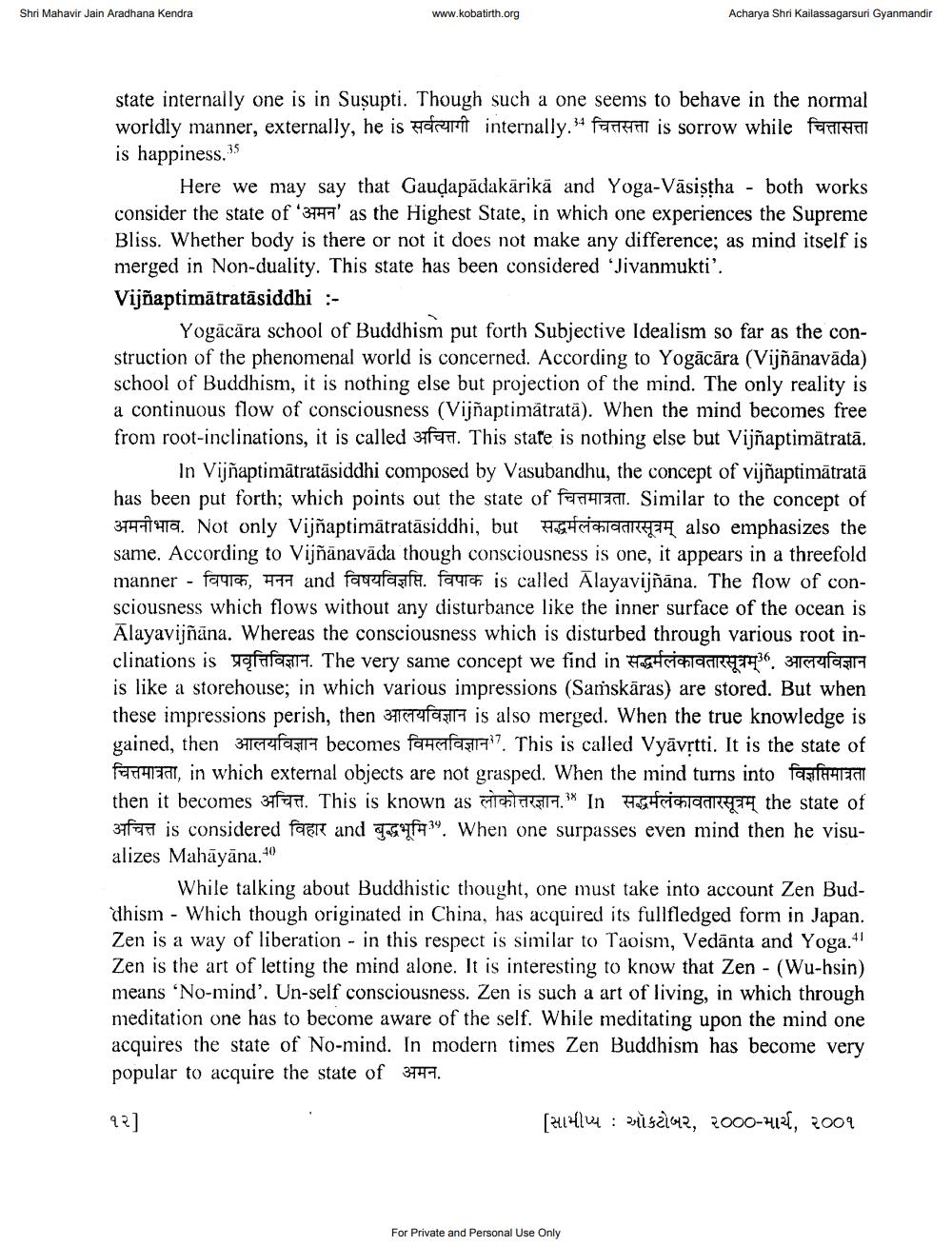________________
Shri Mahavir Jain Aradhana Kendra
www.kobatirth.org
Acharya Shri Kailassagarsuri Gyanmandir
state internally one is in Susupti. Though such a one seems to behave in the normal worldly manner, externally, he is your internally. 34 FETIMET is sorrow while falta is happiness.35
Here we may say that Gaudapădakärikā and Yoga-Vāsistha - both works consider the state of 3777' as the Highest State, in which one experiences the Supreme Bliss. Whether body is there or not it does not make any difference; as mind itself is merged in Non-duality. This state has been considered 'Jivanmukti'. Vijñaptimātratāsiddhi :
Yogäcära school of Buddhism put forth Subjective Idealism so far as the construction of the phenomenal world is concerned. According to Yogācāra (Vijñānavāda) school of Buddhism, it is nothing else but projection of the mind. The only reality is a continuous flow of consciousness (Vijñaptimātratä). When the mind becomes free from root-inclinations, it is called 3tfan. This state is nothing else but Vijñaptimätratā.
In Vijñaptimātratāsiddhi composed by Vasubandhu, the concept of vijñaptimātratā has been put forth; which points out the state of FHET. Similar to the concept of अमनीभाव. Not only Vijnaptimātratasiddhi, but सद्धर्मलंकावतारसूत्रम् also emphasizes the same. According to Vijñānavāda though consciousness is one, it appears in a threefold manner - विपाक, मनन and विषयविज्ञप्ति. विपाक is called Alayavijnana. The flow of consciousness which flows without any disturbance like the inner surface of the ocean is Alayavijñāna. Whereas the consciousness which is disturbed through various root inclinations is yrafast. The very same concept we find in Hasichaaram36. Btufasira is like a storehouse; in which various impressions (Saṁskāras) are stored. But when these impressions perish, then tragis is also merged. When the true knowledge is gained, then 311614fa37 becomes fausia51117. This is called Vyāvrtti. It is the state of Fathat, in which external objects are not grasped. When the mind turns into fazla ESIT then it becomes अचित्त. This is known as लोकोत्तरज्ञान. In सद्धर्मलंकावतारसूत्रम् the state of अचित्त is considered विहार and बुद्धभूमि". When one surpasses even mind then he visualizes Mahāyāna.44
While talking about Buddhistic thought, one must take into account Zen Buddhism - Which though originated in China, has acquired its fullfledged form in Japan. Zen is a way of liberation - in this respect is similar to Taoism, Vedānta and Yoga. 41 Zen is the art of letting the mind alone. It is interesting to know that Zen - (Wu-hsin) means 'No-mind'. Un-self consciousness. Zen is such a art of living, in which through meditation one has to become aware of the self. While meditating upon the mind one acquires the state of No-mind. In modern times Zen Buddhism has become very popular to acquire the state of अमन.
42]
(2114144 : Bus21642, 2000-HC, 2001
For Private and Personal Use Only




